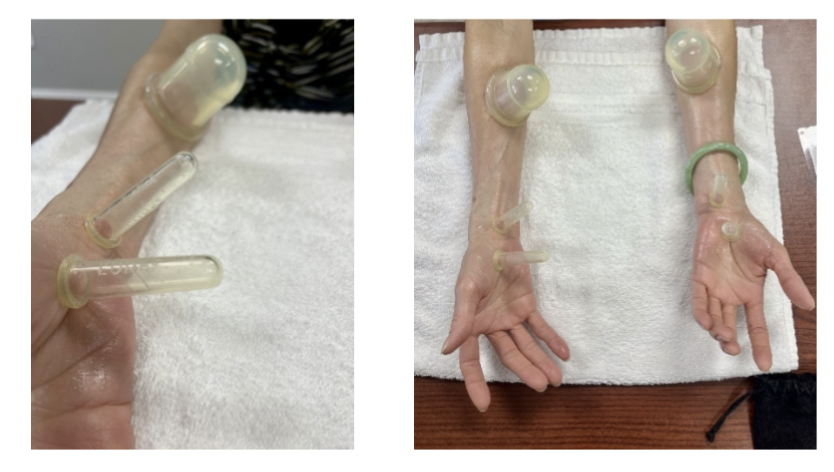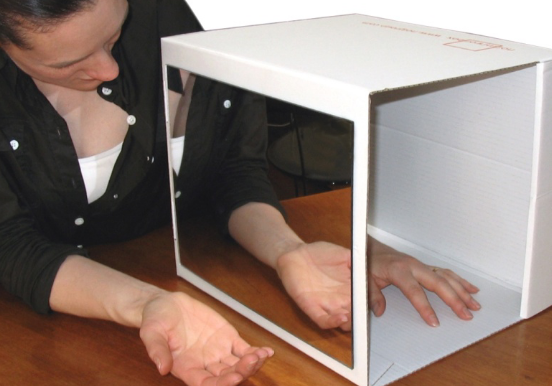Therapeutic Interventions and Contraindications of Cupping
Filed under Treatments
By Kaylen Kallander
Cupping therapy is used to apply negative pressure to a localized area of muscular or neurological pain to relieve nerve pressure and increase blood flow to an affected area. This modality is commonly used for athletes, but is also a frequent treatment in physical therapy, occupational therapy, or hand therapy. While cupping can be an effective and beneficial treatment, it should be used in correct circumstances with specific precautions.
Reasons for Use
- Musculoskeletal injuries/tightness
- Myofascial adhesions
- Neurologic pain with doctor’s approval
Cupping along median nerve pathways modified to use smaller cups for this patient whose arms had less surface area for suction.

Contraindications & Reasons to Discontinue
- Open wounds or acute injury with 24-72 hours
- Neurovascular compromise
- Cardiac or blood malfunction
- Blisters, lightheadedness, or significant pain during use
Considerations
In addition to the appropriate application of cupping therapy, a thorough explanation of treatment effects must be provided to patients. Patients, or parents of minor patients, should give consent before treatment proceeds. Allergies to cupping material, lotion, or oil should be considered as well. Significant bruises are expected and can last from a few days to two weeks. However, treatment should always be within a patient’s pain tolerance. While soreness is normal, it shouldn’t feel worse than having received a deep tissue massage. Patients who have received multiple treatments often present less discomfort with increased suction and decreased bruising over time. Therapeutic effects of cupping treatment can be seen with as little as 5 minutes but should be no longer than 30 minutes if in a static position.
Key Takeaways
Therapy should always be holistic, purposeful, and patient specific. Cupping may be utilized for various diagnoses and pain relief, but patient experience and preference is equally important. Furthermore, a sufficient background of medical knowledge is required to understand potential contraindications to refrain from, delay, or cease treatment. With professional critical reasoning, cupping can be a great modality to use in hand therapy for decreased muscular or nerve pain.
Cage, A. (2019). Clinical Experts Statement: The definition, Prescription, and application of cupping Therapy. Clinical Practice in Athletic Training, 2(2), 4–11. https://doi.org/10.31622/2019/0002.2
4 Comments
Leave a Comment
More To Read
Volkmann’s Contracture
Written by Melissa Miller Introduction Volkmann’s contracture is a rare condition that occurs after injury to the elbow and upper arm, typically from a crush injury. This condition can occur when acute compartment syndrome is left untreated. If unrecognized, Volkmann’s contracture can lead to a permanent deformity in the hand and forearm. Hand therapists are…
Read MoreHand Therapy as a New Grad or Student
Tips for Getting Prepared for hand therapy as a new grad or a Level II Fieldwork Everything you need to know in hand therapy starts with the upper extremity anatomy. Here is a quick checklist to review and hopefully help get you started in your new hand therapy setting. By: Tristany Hightower I suggest, as…
Read MoreGraded Motor Imagery in Hand Therapy
The 3 Stages of Graded Motor Imagery We’ve all heard of mirror box therapy, but do you know the details of how it works? There’s actually 3 stages involved that exercise the brain and take advantage of its plasticity. There is a great deal of evidence supporting these three stages and you can use them…
Read MoreSign-up to Get Updates Straight to Your Inbox!
Sign up with us and we will send you regular blog posts on everything hand therapy, notices every time we upload new videos and tutorials, along with handout, protocols, and other useful information.






I love your blog posts. Short and full of little gems.
Thank you for your kind words! We love sharing.
I would add to always include active movement with your cupping treatments for best results.
That is a great tip as well!